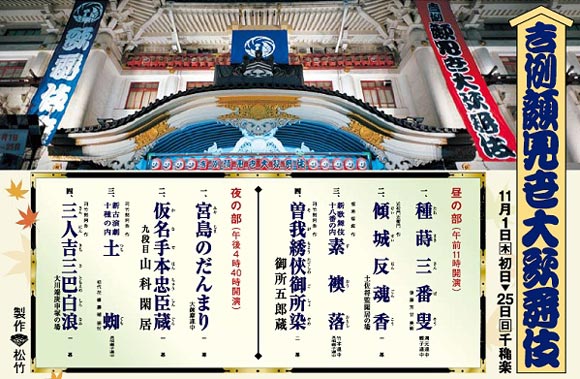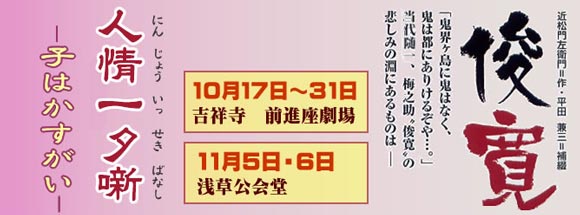| NOVEMBER 2007 |
|
4 shows in T˘ky˘ (Kabukiza, National Theatre, Asakusa K˘kaid˘) and 2 tours (Sh˘chiku Grand Kabuki Tour, Band˘ Tamasabur˘ Tour)!
|
|
|||
| Dates | 1 ~ 25 November 2007 (Kichirei Kaomise K˘gy˘ Kabuki) | ||
| MatinÚe |
Keisei Hangonk˘ (Domo Mata) |
||
| Evening | |||
| Casting |
Nakamura Kichiemon, Kataoka Nizaemon, Onoe Kikugor˘, Nakamura Tomijűr˘, Nakamura Shikan, Nakamura Shibajaku, Matsumoto K˘shir˘, Nakamura Kaishun, Nakamura Baigyoku, Ichikawa Sadanji, Onoe Kikunosuke, Kataoka Takatar˘, Nakamura Fukusuke, Onoe Sh˘roku, Nakamura T˘z˘, Nakamura Kinnosuke, Nakamura Karoku, Nakamura Kash˘, Ichikawa Somegor˘, Nakamura Tamatar˘, Nakamura Takanosuke |
||
| Comments |
|
||
 |
|||
| National Theatre (T˘ky˘) |
| Dates | 3 ~ 26 November 2007 |
| Program |
Sesshű Gapp˘-ga-Tsuji |
| Casting |
Sakata T˘jűr˘, Band˘ Mitsugor˘, Kataoka Gat˘, Nakamura Kanjaku, Nakamura Senjaku, Kataoka Hidetar˘, Band˘ Hikosabur˘ |
| Comments |
First performed as a puppet play in 1773, this play shows the searing passion of a stepmother for her son, a story that began with a legend in India and became the great classic of French theatre, ôPhedreö by Racine and took the form of the love of Tamate Gozen for her stepson in this play. In the puppet play, this forbidden desire is explained in the typical manner of a history play, as a way to reconcile conflicting duties. But nevertheless, the scandalous theme has made the play often banned, even as the climactic scene has become one of the great classics of both Kabuki and Bunraku puppet theatre. In November at the National Theatre there will be the first full-length performance of the play in thirty-nine years. Plays originally from the puppet theatre are a specialty of the distinctive Kansai style of acting and this monthĺs production features Living National Treasure Sakata T˘jűr˘ (Tamate Gozen), Kataoka Gat˘ (Gapp˘) and Kataoka Hidetar˘, three of the foremost actors in the Kansai acting style. Also featuring Band˘ Mitsugor˘ as Takayasu Shuntokumaru. Tamate Gozen has become the second wife of a great lord, Takayasu Saemon Michitoshi. He has two sons, Takayasu Shuntokumaru and Jir˘maru. Although Takayasu Shuntokumaru is designated heir to the clan, Jir˘maru plots to seize power instead. Suddenly Tamate Gozen confesses her love for Takayasu Shuntokumaru. He flees the mansion now disfigured by a strange illness. Eventually all the parties to the drama come to the house of Tamate Gozenĺs father, a priest named Gapp˘, where Takayasu Shuntokumaru has taken refuge. In this tense scene, Tamate Gozen confesses her passion, Gapp˘ is forced to kill his daughter and finally, all the secrets are revealed in the surprising conclusion. |
| Sh˘chiku Grand Kabuki Tour | |
| Dates | 30 October ~ 26 November 2007 |
| Program | |
| Casting |
Ichikawa Kamejir˘, Ichikawa Danshir˘, Band˘ Takesabur˘, Ichikawa Monnosuke, Nakamura Kikaku, Band˘ Shinsha |
| Comments |
|
| Band˘ Tamasabur˘ Tour (Band˘ Tamasabur˘ Tokubetsu Buy˘ K˘en) |
|
| Dates | 30 October ~ 25 November 2007 |
| Program |
Okuni Kabuki Yume no Hanayagi |
| Casting |
Band˘ Tamasabur˘, Ichikawa Danjir˘, Ichikawa Emisabur˘, Ichikawa Shun'en, Ichikawa En'ya |
| Comments |
The great star Band˘ Tamasabur˘ is on tour with the yound and talented actors of the Omodakaya guild. |
|
|||
| Dates | 5 ~ 6 November 2007 | ||
| Program |
Heike Nyogo no Shima (Shunkan) Ninj˘ Isseki Banashi |
||
| Casting |
Nakamura Umenosuke, Arashi Keishi, Kawarasaki Kunitar˘, Segawa Kikunoj˘, Fujikawa Yanosuke, Osagawa Genjir˘, Arashi Hironari, Yamazaki Tatsusabur˘ |
||
| Comments |
|
||
 |
|||
|
|
| Contact | Main | Top | Updates | Actors | Plays | Playwrights | Programs | Links | FAQ | Glossary | Chronology | Illustrations | Prints | Characters | Derivatives | Theaters | Coming soon | News |
